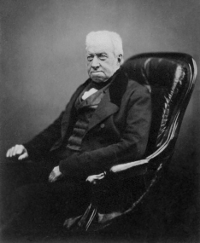

Robert Brown was born on 21 December 1773 in the town of Montrose, Scotland. He attended the University of Edinburgh where he firt becacme interested in botany. After leaving the University he traveled widely, first to Ireland and then to Australia during which he conducted extensive and groundbreaking botanic research. In 1837, Brown was appointed as the first head of the newly created Botanical Department of the British Museum. As a scientist, Brown is best known for his early use of the microscope and detalied descriptions of cell nuclei. In Brown died on 10 June 1858 in London.
To students of probability, Robert Brown is famous for his observations in 1827 of the motion of tiny particles from pollen suspended in water, now known as Brownian motion in his honor. As an idealized mathematical random process, Brownian motion is one of the most important processes in probability theory. Indeed, Brown's name is attached to an entire subfield of probability that includes geometric Brownian motion, the Brownian bridge, Brownian sheets, and fractional Brownian motion, to name just a few.